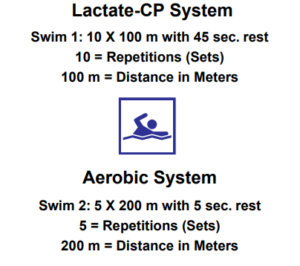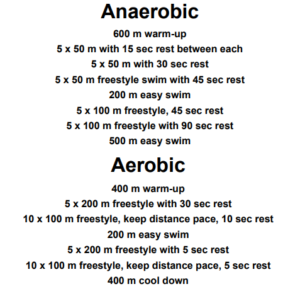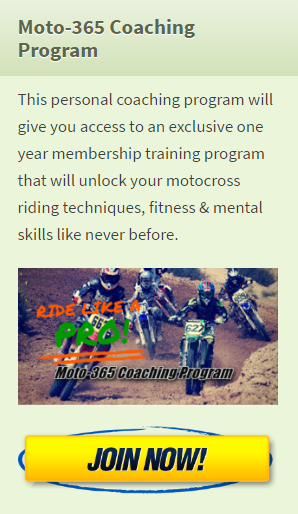Pool Training: Building Motocross Strength and Endurance
The major reason to use a pool is the quality of training. Swim sessions may be
closely monitored and are safe. Controlled interval workouts used in pool training sessions
provide good feedback; the pace clock doesn’t lie. Pool sessions allow you to design
workouts that vary in intensity and emphasis, which is not possible in open water. Pool
training and acquisition of improved stroke skills are elective elements of a motocross training
program. Pool training will increase your comfort level in open water, thus enabling you to
significantly improve your motocross technique capabilities.
Warming Up
Warming-up should consist of at least 400 meters of swimming, along with some
kicking and pulling drills. Warming-up is essential for swimming to avoid developing
problems of the shoulder joint and upper back.
Target heart rate during warm-up should be
about 60% of maximal.
During your warm-up, work on efficient stroke “stealth” swimming! Warming-up
is an appropriate time to include stroke drills. This serves the purpose of providing stroke
patterning along with the warm-up.
Basic Principles of Interval Training
Motocross racers & riders need to concentrate on swim training that will enhance endurance:
interval swim training will allow this to happen. Interval training sets (for both strength and
endurance) are generally comprised of repeated swims lasting 45 seconds to 4 minutes.
Basics of interval training include the following:
- Swim at a slow to moderate pace for five to ten minutes to warm-up muscles
and cardiorespiratory system. - For anaerobic training, sets should be performed until repeat times can no
longer be held. There is no magical number of repetitions for a set, but the
distance is typically 50 to 100 meters, or a time of about 45 seconds. - Swimming at a prescribed intensity pace for as long as possible is most
important. When desired pace can no longer be sustained, the set should be
terminated. - Work:recovery ratios play an important part in the type of adaptation that
occurs. A 1:1 work:recovery ratio would be to swim 45 seconds and rest 45
seconds, whereas a 1:2 ratio would be to swim 45 seconds and rest 90 seconds. - To stimulate endurance adaptations, recovery intervals between repetitions
should be less than 30 seconds. For maximum benefit, it is best to keep the
interval less than 15 seconds. - For anaerobic adaptations to occur, recovery intervals should be in excess of
one minute and up to at least twice the duration of the repetition swim. These
effects occur independent of the repetition distance or pace. - The longer the rest interval, irrespective of the distance being repeated, the
greater the use of the anaerobic system. With long rests, it takes considerably
longer for the aerobic energy system to be reactivated. Short rest intervals
keep the aerobic system functioning, particularly during initial recovery
Interval training is the backbone of a swimming workout
Below demonstrates how the different energy systems can be trained in an interval
workout. Swim 1 is a hard effort, short distance and a lot of rest; this type of effort builds
the anaerobic (CP) and transitional (Lactate-CP) energy systems. The second swim consists
of fewer sets at a longer distance and with shorter rest intervals; this swim would challenge
the aerobic system.
Energy Systems Used During Interval Sets

Interval Sets – Endurance
Freestyle Swim: 10 x 50 m with only 5 sec. rest
- Rest 5 seconds between each swim.
- Start with efficient “stealth” stroke, work into distance race pace. Don’t overkick.
- Try to match your 1000 meter pace with this set
Freestyle Swim: 50-50-100 m with 5 sec. rest
- Swim 2 x 50 meters with 5 seconds rest, then swim 100 meters: Repeat 3X.
- This set builds into a 100 meter swim where the swimmer tries to match the
pace set in the 50 meters. - Back off of the 50 meters a little to save up for the 100 meters.
” If you want, add an extra 15 seconds of rest between each 50-50-100 to keep
the quality up. - A “buildup” set like this will do great things for your endurance and sense of
pace.
Freestyle Swim: 10 x 100 m with 10 sec. rest
- Rest 10 seconds between each 100 meter swim.
- Swim smoothly and efficiently. This is the set where you may exceed your
long, slow swimming 1000 meter time!
Breaststroke Swim: 50-50-100 m – 5 sec. rest
- Done like the freestyle 50-50-100 set outlined above.
- Concentrate on keeping effort level up.
Interval Sets – Strength and Power
Freestyle Swim: 10 x 50 m with 30 sec. rest
- Begin at a strong pace. Build to race pace with a strong turn and an extra
strong finish. Try to be within 5 seconds of your race 50 meters pace, usually
equal to your race 200 meter pace. - At first, try just 5 x 50 meters with 30 second rest.
- This is the most power-oriented freestyle set. It will also allow you to discover
your true maximal heart rate. If you start to die off at the end, increase
your rest a little to keep your pace. - If you are particularly strong and want to build more speed, do this set with
zoomers.
Freestyle Swim: 10 x 100 m with 45 sec. rest
- Same pace approach as the 50 meter interval set. This is for advanced swimmers
with a refined stroke. It will build power, but this set should be used no
more than once every two weeks. - The rest interval should be 45 seconds for this length of swim; adjust your
interval accordingly.
Breaststroke Swim: 10 x 50 m with 30 sec. rest
- Like backstroke, work on hard swimming with about 30 seconds of rest.
Breaststroke is very taxing when done hard but like bicycling it is easy to
throttle back and have the appearance without the substance.
Integrated Workouts
For pool training it is necessary to integrate your sets into a comprehensive
workout. At first you will want to limit your hard sets, but as your fitness improves, hard
drills can be extended. It also worthwhile alternating between anaerobic and aerobic
workouts. In this way your performance for motocross racing & riding should be
optimized.
Sample Anaerobic and Aerobic/ Endurance Swim Interval Workouts

So I have a question... what happens when you first start riding…
You learn the basics of controlling your bike and you’re able to make it around the track a few times. Heck, you might even master the straightaway and get great speed. But then you get to a corner and you have trouble controlling the bike as you come into the corner or you lose speed coming out of the corner. This slows you down on the track. Then you finally get up the courage to try out a jump, but again you lose control of the bike mid-air and the tail end starts to get away from you.
Is this sounding familiar? Trust me, you’re not alone! I seen hundreds of guys like you every week on my track. You probably just think that you need more and more practice to reduce your track time, hit your corners and make your jumps, but that’s the LAST thing you should be doing!
Why? Because you will be practicing all wrong. You will be training your body to keep making these mistakes and you will never race at the level you want. Unless…
You fix the big mistake that you’re making once and for all. I’m about to let you in on a little known motocross secret that us pros usually keep to ourselves. But I don’t want you to have to struggle for years all by yourself like I did. I want you to finally have FUN riding, so listen up…
Before you even THINK about getting on your bike again, the first thing you have to master is… your Fundamental Techniques!
The biggest mistake most beginner riders make is getting on a bike without first training your ‘riding techniques & Riding core’. Without strong fundamental techniques you won’t be able to fully control the 250 pound bike between your legs so you’ll keep sliding through your corners, fishtailing during jumps and you’ll end up exhausted after just a few laps.
And I’ve seen too many guys wipe out on the track and end up in the hospital all because they didn’t practice there techniques and train their core the RIGHT way.
Don’t be one of those guys! Jump into the Moto-365 program and learn the RIGHT way to control your bike and improve your fitness. You’ve already spent thousands of dollars on your riding gear, click the button below to discover how to finally ride like a pro!


